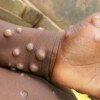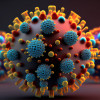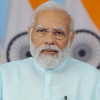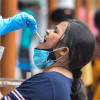
 Mr. Swapnil Bhowmick
Mr. Swapnil Bhowmick
Will India See A Third Wave Of COVID -19?
The possibility of a third wave of Covid-19 infections has been raised by health officials. There have been certain questions raised in the public interest that will be covered in this article to deal with the current situation.
● What, at the national and regional levels, constitutes a wave in an epidemic?
● How probable is a third wave, and how terrible will it be?
● Will the 2nd wave merge into the 3rd wave or will there be a gap between them?
● When will the 3rd wave start?
Covid-19 has been unrelenting during the previous year and a half, although there have been moments of a spike followed by a relative pause in every region. So far in India, there have been two major surges separated by a lengthy gap.
What is an Epidemic Wave?
There is no academic definition of what makes an epidemic wave. The word is used in a broad sense to describe the growing and falling trends of infections throughout time. The growth curve has the appearance of a wave.
Historically, the word wave referred to the disease's seasonality. Several viral infections are seasonal in origin and re-occur at regular periods. Infections increase and then fall, only to climb again after a while.
What Constitutes an Epidemic Wave at the National & Regional Levels?
In the case of Covid-19 too, we can see the pattern at a national as well as at a state/district level. At the national level, India witnessed the first wave last year when the country reported a peak of nearly 98,000 new daily infections in September.
The number of new infections per day steadily decreased, indicating a quiet time. Because many people thought the pandemic was over, preparations for the second wave, which is currently affecting India, were neglected. Presently, the second wave is exhibiting a small drop.
Will the 2nd Wave Merge into the 3rd Wave or Will There be a Gap between them?
The terrible second wave of Covid-19 in India has hardly subsided, and there is already discussion of the next round.
As parts of the country continue to relax restrictions, a mathematical model developed this week by the Indian Institute of Technology, Kanpur, predicts three possibilities for a possible third wave in the country.
The model predicts that the majority of the Covid-19 limitations will be lifted by July 15. In the worst-case scenario, India might witness up to 500,000 cases each day, peaking in September (the second wave peaked at around 400,000 cases in May). In the best-case scenario, there might be 200,000 instances every day.
Both scenarios predict a third wave that is much greater than India's first wave, which peaked at 98,000 cases per day in September 2020. The researchers stated that successful immunization programs might reduce this peak, although they did not specify to what amount.
Some health experts believe that a third wave may begin as soon as the next six or eight weeks. Health experts in Maharashtra, one of the worst-affected states during the second wave, have stated that if all restrictions are relaxed, as they have begun to do in some areas of the state.
From the recent scenario, it is evident that the second wave will soon merge into the third wave.
Will the Third Wave be More Powerful than the Second Wave?
India’s financial capital, battered by the second wave of Covid-19, could already be staring at an imminent third wave and soon.
The western state of Maharashtra, of which Mumbai is the capital, could see the third wave of Covid-19 as early as in the next two to four weeks. The predictions and warnings from the state government’s health department are a consequence of several cities lifting their restrictions and life returning to a crowded normal.
Uncontrolled crowds and disrespect for Covid standards such as mask-wearing and preventing non-essential mobility are concerning.
The Delta Variant of COVID 19
The fast increase in cases in places such as Delhi and Mumbai is most likely due to a mutation of the new coronavirus, which was discovered in India. The B.1.617.2 or Delta variation is almost 60% more transmissible than the Alpha version (or B.1.1.7), which was discovered in the UK originally.
According to research conducted in the United Kingdom, the Delta variation may increase hospitalizations and make vaccinations less effective.
According to statistics analyzed by the UK's Public Health England, a single dosage of the AstraZeneca vaccine, known as Covishield in India, is only 33% effective against the Delta strain and has a decreased effectiveness of 60% after two doses (PHE).
In light of this, it is even more important to thoroughly vaccinate as many individuals as possible.
The Bottom line
As per studies conducted recently, children might not be affected as it was predicted earlier but still, precautions need to be taken. People should continue to follow guidelines. Wear a mask whenever outside and maintain hygiene.
One thing that this pandemic has taught us is that self-hygiene is a must, and should not be compromised at any cost.

Mr. Swapnil Bhowmick
A motivated student of Medicine & Surgery (MBBS) at R. G. Kar Medical College & Hospital, Kolkata, having a knack for reading and composing medical literature. When he's not writing content for MEDtalks, Swapnil is usually looking up the latest trends and innovations in Medicine.














Please login to comment on this article